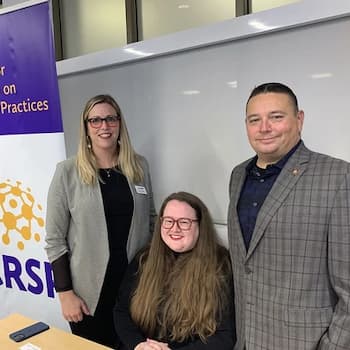Technologies
The technologies theme explores the various ways in which technologies are developed, adopted, appropriated, resisted, governed and used in practice, to provide critical insights into their intended and unintended outcomes and impacts. Research in this stream moves beyond a technological deterministic analysis of security technologies to provide analyses that look at the ways social, political, economic and organizational contexts get inside and shape technologies, as well as to the ways in which technologies shape these same contexts.
Current Research Projects
Information technologies and analytic platforms are an integral part of policing practices. Yet, as police acquire access to increasingly larger data sets, technological platforms and autonomous technologies (e.g., facial recognition software and predictive policing) the more their work retreats behind a ‘technological veil’ that has serious implications for public trust and policing accountability. Central to this new data-driven policing movement is the intelligence analyst, who, working with analytic technologies, translates raw data into intelligence products to predict, identify and disrupt crime. In doing so, analysts engage in sensemaking and use their “craft” (combination of creativity, spontaneity, rigour, and systematic character of science) to sort through and digest large volumes of data to identify what is important and reliable, decide analytic techniques, and draw inferences to inform police decision-making.
This project empirically investigates the craft of intelligence analysis. The research involves an innovative mix of analytic scenarios and observational analyses, semi-structured interviews and documentary analysis to address the following objectives:
- To examine how intelligence analysts construct intelligence products, and the knowledge, rationalities, and decisions that inform the craft of intelligence analysis.
- To identify the training, expertise, and competencies that analytic managers hold, and how these shape the craft of intelligence analysis.
- To determine how the technical design of intelligence technologies shapes the craft of intelligence analysis, and identify the assumptions (e.g., about crime, risk, harm) that are embedded in the design of intelligence software.
- To uncover the public goods and harms associated with the socio-technical construction of intelligence analysis.
The research will make visible the low-visibility processes embedded in the craft of intelligence analysis, while also empirically identifying the public goods and harms associated with its production.
Data analytics and big data technologies (BDT) are tools that enable identification and prediction of patterns in large data sets that hold great promise for increased efficiency and innovation in policing and security. At the same time, citizens are increasingly concerned that the use of such technologies is potentially detrimental to individual privacy and civil rights. To date, there is little empirical research on how data analytics and BDT are used and experienced in security organizations– especially within the Canadian context – to inform evidence-based policy and practice development, or discussions on the ethics, regulation and governance of intelligence practice. Access to police services to conduct empirical studies on intelligence analysis is significantly restricted due to privacy and security concerns, and the fear that the presence of researchers may impede investigations. Given the rapid adoption of these technologies within the security sector, there is a growing need for institutional spaces that facilitate research in the field of intelligence analysis.
Dr. Carrie Sanders has recently received infrastructure funding from the Canada Foundation for Innovation, Ontario Research Fund, and vendors to establish the, Craft of Intelligence Analysis Lab (CIAL), a lab that simulates a “real” criminal intelligence analysis unit and will enable Dr. Sander’s to: (1) examine how intelligence analysts build intelligence products, (2) examine what (and how) technologies and analytic practices are used in the construction of intelligence products; (3) identify the facilitators and barriers (e.g., ethical, legal and governance structures and professional standards) to the use of analytical technologies in intelligence analysis; and, (4) identify what training, support, and career opportunities are needed to help analysts utilize the innovative benefits of these technologies.
This space will feature four workstations with desk-top computers where the analysts will have access to hypothetical data and scenarios created by experts to closely resemble real cases as well as technologies, data bases, and platforms that assist in the examination and production of intelligence. To observe the analysts, researchers will have access to ceiling-mounted cameras as well microphones positioned within the space and at analysts’ workstations to record the interactions of analysts. Construction of the lab will be complete in the fall of 2020 and research projects within space will commence shortly thereafter.
CIAL will enable Dr. Sanders and her team to closely observe, record, and interview analysts as they work in real time to capture the scientific, technological, and “craft” (knowledge, skills and judgements incorporated in practices) skills required for conducting intelligence analysis.
Past Research Projects
DR. PATRICK WATSON'S SSHRC FUNDED RESEARCH
Do you share a Netflix, Spotify, Hulu, etc. streaming account with your family, friends, or strangers? Do you ever wonder how your account gives you weird recommendations after you share your password with your new boyfriend or girlfriend? If so, we want to talk to you! Gaming Predictive Subscription Algorithms is a one-year project examining how content streaming services users make sense of the recommendation algorithms these services employ. We’re particularly interested in users who share accounts with people they don’t live with, since these tend to be the scenarios where the recommendation algorithm makes the strangest recommendations. There is a lot of scholarly interest in how people interact with algorithms and other digital agents, but the problem is, most of the time, we don’t know that we are interacting with them. Algorithms are being used more and more every day to predict what we might do, either collectively or individually, and the services we use and organizations we interact with are being guided by them, but for the most part these remain hidden to us and we don’t know a ton about how they work or how we should feel about them. Recommenders, on the other hand, are algos that we “see” working all the time and interact with more-or-less directly, so our question is “how do people feel about those interactions?” Knowing more about this will lead us to better understand what impacts algos and digital agents are having on our lives.
High profile police killings of citizens, concentrated in the United States of America (USA), have contributed to a crisis in public perceptions of police legitimacy, prompting demands for police reform. Police across the USA have begun adopting body-worn cameras (BWCs), in part, to improve strained community-police relations. Police adoption of BWCs is cast as essential to contemporary USA policing, setting a new global standard. In Canada, large trendsetting police services (including the RCMP, Toronto, Calgary and Edmonton) have piloted BWCs. The limited research available on the effects of BWCs on policing is mixed, USA-centric, and quantitative in nature with little qualitative work exploring officers’ perceptions of, and experiences with using them. To address this gap in knowledge, Drs. Alana Saulnier and Carrie Sanders have undertaken one of the first major qualitative analyses into the perceived and actual impact of BWCs on frontline policing practices in Canada. Specifically, the research uses interviews with police officers and document analysis to:
(1) Examine the factors that influence officers’ perceptions of BWCs.
(2) Uncover how officers perceive BWCs impact their relationships with their employer, colleagues, and members of the public.
(3) Explore how occupational performance is influenced by the use of BWCs.
(4) Create a Canadian BWC policy template informed by analyses of domestic policies, international guidelines, and Canadian officers’ experiences.
This is one of the first major empirical investigations into the perceived and actual impact of BWC on Canadian policing in addition to being amongst the first to conduct an analysis of Canadian police service BWC policies. The project will enhance the domestic and international literature on policing and BWCs by providing empirical insights into the theory and practice of contemporary policing strategies, and the opportunities, risks, strategies, and best practices for useful and ethical deployment of BWCs.












